Geoff Regan Looks to Keep Role as Speaker of the House of Commons in Canada
Josiah Wedgwood spent his life perfecting the art of pottery, establishing 260 years ago the company that bears his family name. His near-perfect works were and still are the choice for monarchs, heads of state, and purveyors of good taste worldwide.
Wedgwood came from a family of well-established potters in Staffordshire, England. His father, brother, and cousins all worked in the craft. But it was Wedgwood (1730–1795) who became known as the “Father of English Potters.”
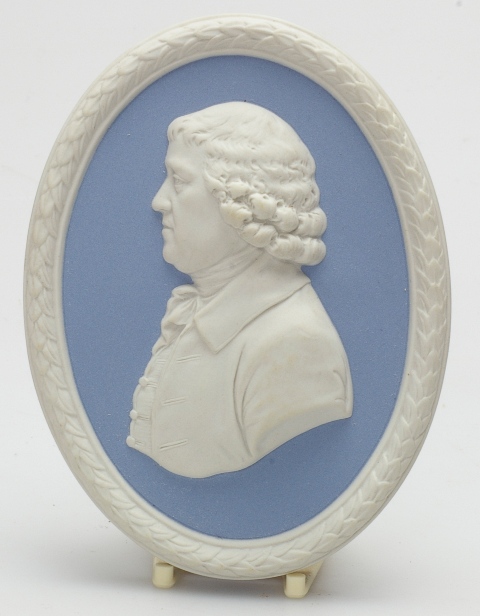 A Jasperware portrait medallion of Josiah Wedgwood. (Fiskars UK Ltd.)
A Jasperware portrait medallion of Josiah Wedgwood. (Fiskars UK Ltd.)He created new ceramics such as Queen’s Ware (1762), Black Basalt (1768), and Jasper (1774). And he pioneered a novel approach to selling, which we now know as marketing. Wedgwood knew his customers, enjoyed experimenting, and had a deep appreciation of beauty and the art of the ancients.
Aspiring to Ancient Perfection: The Barberini Vase
Wedgwood’s most acclaimed piece of pottery is his Portland Vase, a reproduction of the exquisite ancient Roman Barberini Vase made around A.D. 1–25.
“Except the Apollo Belvedere, the Niobes, and two or three others of the first-class marbles, I do not believe that there are any monuments of antiquity existing that were executed by so great an artist,” wrote Sir William Hamilton on July 24, 1786, about the Barberini Vase. Hamilton, the British ambassador to the kingdom of Naples, was also an avid antiquarian.
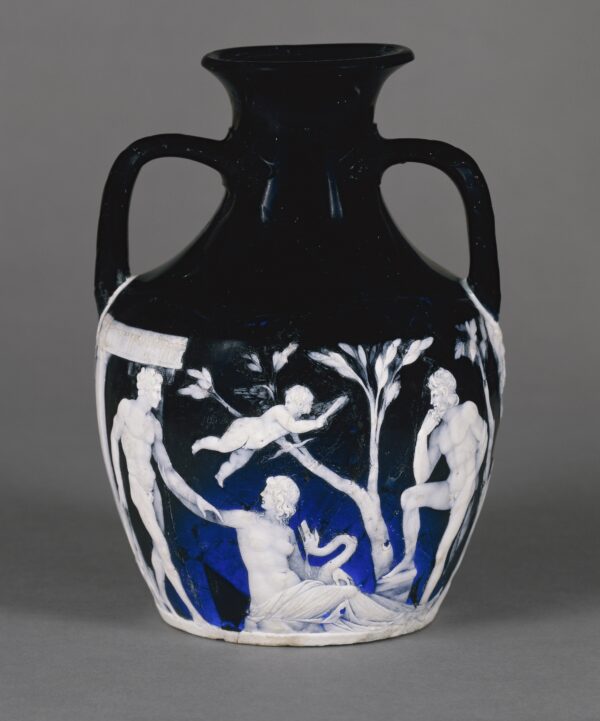 The Barberini Vase, circa A.D. 1-25, is made of dark cobalt blue and opaque white cameo glass. (Trustees of The British Museum)
The Barberini Vase, circa A.D. 1-25, is made of dark cobalt blue and opaque white cameo glass. (Trustees of The British Museum)Today, the Barberini Vase, held at The British Museum in London, is still thought of as the foremost example of ancient cameo glass. At first glance, the vase appears black, but a closer look reveals translucent dark cobalt blue and opaque white cameo glass. The vase was probably part of a funeral monument and is thought to have been an amphora, but the amphora’s pointed base had been damaged and repaired to a flat but uneven base.
The Barberini Vase Comes to England
The Barberini Vase came to England in 1783 with a number of items Hamilton brought with him from Italy that he intended to sell. The Dowager Duchess of Portland bought the vase from him for her private museum collection, and thereafter it became known as the Portland Vase. For simplicity, in this article the name “Barberini Vase” will refer to the original and “Portland Vase” to Wedgwood’s copy.
Sculptor John Flaxman wrote to Wedgwood on Feb. 5, 1784, telling him about the Barberini Vase that had just arrived in England to much acclaim. Flaxman thought it to be the “grandest & most perfect Greek Sculpture.”
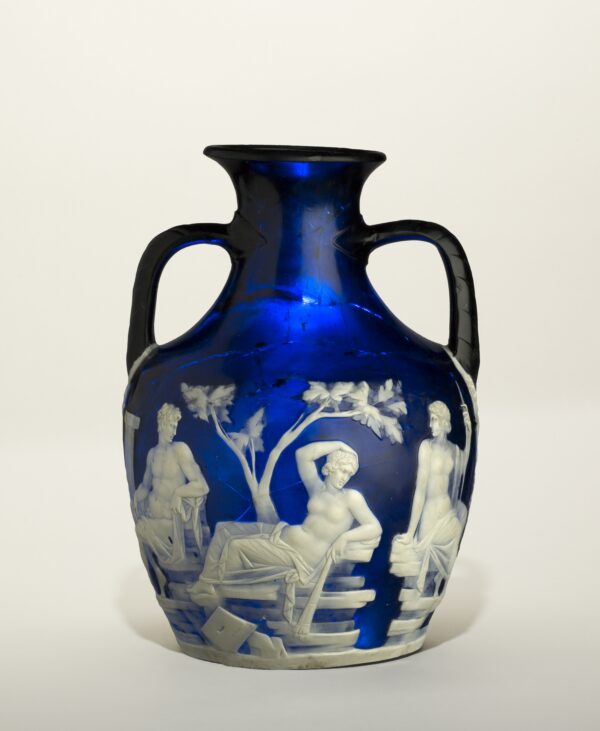 The Barberini Vase, circa A.D. 1-25, is made of dark cobalt blue and opaque white cameo glass. (Trustees of The British Museum)
The Barberini Vase, circa A.D. 1-25, is made of dark cobalt blue and opaque white cameo glass. (Trustees of The British Museum)“It is the finest production of Art that has been brought to England and seems to be the very apex of perfection to which you are endeavoring to bring your bisque & jasper,” he wrote in the same letter, mentioning the unglazed ceramics Wedgwood used, with Jasper being Wedgwood’s own innovation. Having worked with Wedgwood on numerous occasions, Flaxman would’ve known what Wedgwood aspired to in his artwork.
Flaxman’s assumptions were correct, but it wasn’t until June 10, 1786, that Wedgwood secured a loan of the Barberini Vase just three days after it was sold to the third Duke of Portland at the estate sale of his mother, the Duchess of Portland.
Reproducing the Barberini Vase
Wedgwood was already reproducing ancient classical vases, catering to the growing interest in classical works at the time. During the time that Wedgwood made his Portland Vase, he had been producing black basalt vases, which had Greek and Roman scenes copied from Hamilton’s collection of ancient ware, the Wedgwood Museum archivist Lucy Lead said in a phone interview.
The 18th century was a time of increased interest in all things antique due to archaeological excavations in Rome, and the advent of the commonplace gentlemen’s grand tour visiting these great ancient sites.
“People were starting to move toward neoclassicism, … and these [classical] pieces were deemed to have reached the pinnacle of good style and taste in ancient times. When people like Wedgwood are reproducing and manufacturing them again, they are tapping into the general vogue of the period,” Lead said.
Wedgwood chose to reproduce the Barberini Vase in Jasperware, a stoneware of his own innovation. He spent about four years trying to perfect Jasperware, Lead said. “Nobody had ever seen anything like this previously anywhere within the ceramic world, so Jasper really is a unique invention,” Lead said.
Jasperware is a stoneware ceramic, which means that after firing, it doesn’t need to be glazed. What makes it so special is that it’s white stoneware that can be colored by adding various metallic oxides of black, blue, pink, yellow, red, or whatever color is required.
Making a Barberini Vase in clay doesn’t produce an exact replica. Clay doesn’t have the translucent qualities of the blue-black glass of the Barberini Vase, and although Flaxman made delicate and exacting copies of the bas-reliefs, his Jasper reliefs could never match the opaque cameo glass of the original.
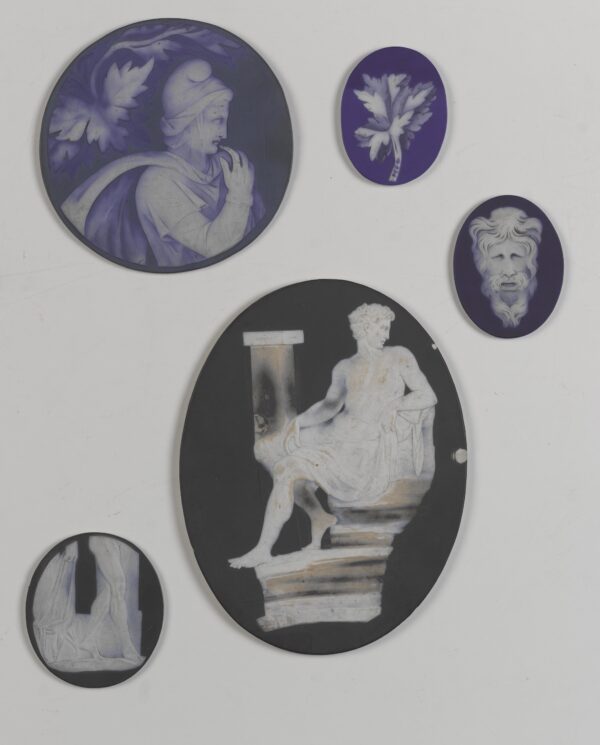 Josiah Wedgwood and his craftsmen undertook many trials to reproduce the Barberini Vase. Many can be seen at the Wedgwood Museum. (WWRD/Wedgwood Museum)
Josiah Wedgwood and his craftsmen undertook many trials to reproduce the Barberini Vase. Many can be seen at the Wedgwood Museum. (WWRD/Wedgwood Museum)Although Wedgwood was skilled in copying antiques, reproducing the Barberini Vase proved no easy feat. He’d seen an illustration of the vase in one of 15 volumes of French archaeologist Bernard de Montfaucon’s “Antiquity Explained and Represented in Diagrams.”
It seems that in seeing the vase in person, rather than on paper, Wedgwood came to understand why Hamilton compared its workmanship to that of the finest of ancient marbles. “I proceeded with spirit, on sufficient assurance that I should be able to equal, or excel, if permitted, that copy of the vase; but now that I can indulge myself with full and repeated examinations of the original work itself, my crest is much fallen,” he wrote to Hamilton.
But Wedgwood persevered. Wedgwood, his son Josiah Wedgwood II, and his craftsmen, including Flaxman, took four years to perfect the manufacturing of the Portland Vase. He kept detailed accounts of the processes for all his work in his oven book, a record of his firings. Along with the book, The Wedgwood Museum has two examples of trial pieces made on his way to perfecting the Portland Vase. One vase shows fractured reliefs that had fallen off, and the other shows where the ceramic body bubbled in the kiln. Trials of the various enamel work can also be seen, where Wedgwood experimented with the color, tones, and shading.
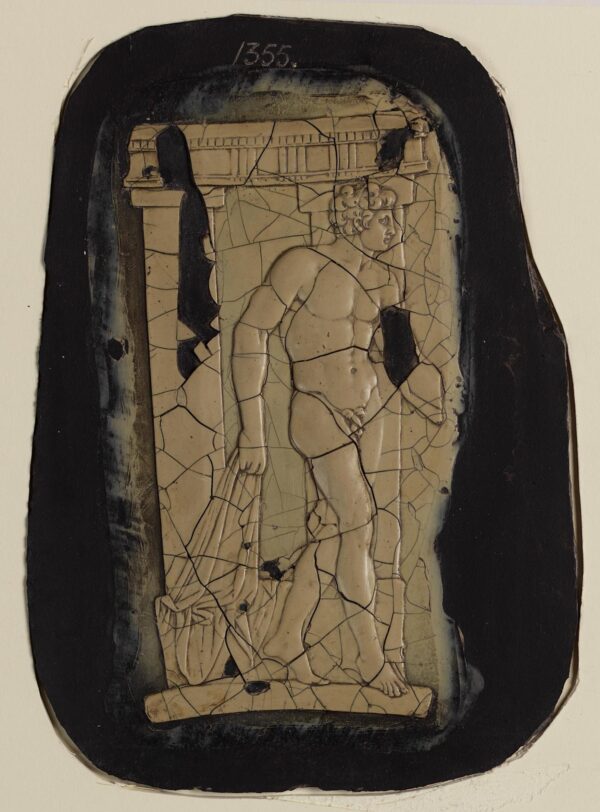 Wedgwood’s wax mold that was used to make a cast for manufacturing the reliefs on the Portland Vase. (WWRD/Wedgwood Museum)
Wedgwood’s wax mold that was used to make a cast for manufacturing the reliefs on the Portland Vase. (WWRD/Wedgwood Museum) Wedgwood’s wax mold that was used to make a cast for manufacturing the reliefs on the Portland Vase. (WWRD/Wedgwood Museum)
Wedgwood’s wax mold that was used to make a cast for manufacturing the reliefs on the Portland Vase. (WWRD/Wedgwood Museum)Wedgwood’s diligence paid off. On June 15, 1790, Sir Joshua Reynolds, who was the president of the Royal Academy of Art, deemed Wedgwood’s Portland Vase a “correct and faithful imitation both in regard to general effect, and the most minute detail of the parts.”
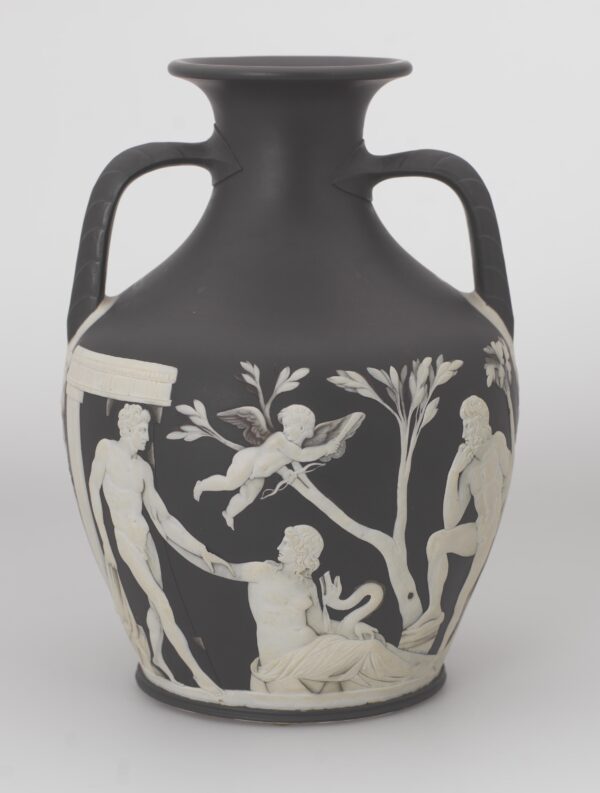 The original Portland Vase by Josiah Wedgwood. Jasperware. The vase is the result of four years’ work to perfect the manufacturing process. (WWRD/Wedgwood Museum)
The original Portland Vase by Josiah Wedgwood. Jasperware. The vase is the result of four years’ work to perfect the manufacturing process. (WWRD/Wedgwood Museum)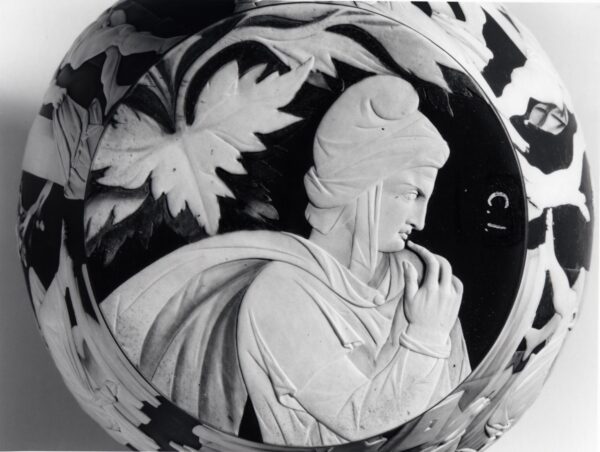 On the base of Wedgwood’s Portland Vase is a figure thought to be the ancient Greek named Paris. (WWRD/Wedgwood Museum)
On the base of Wedgwood’s Portland Vase is a figure thought to be the ancient Greek named Paris. (WWRD/Wedgwood Museum)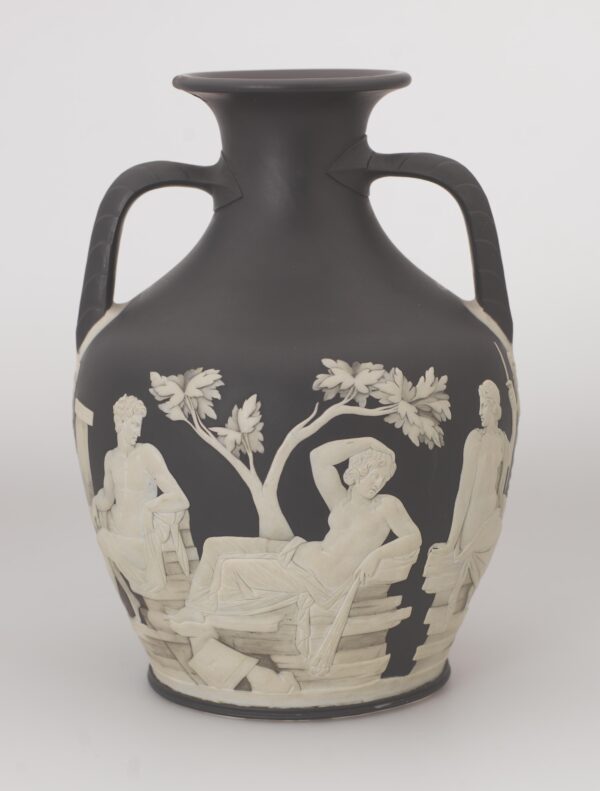 The original Portland Vase by Josiah Wedgwood. Jasperware (WWRD/Wedgwood Museum)
The original Portland Vase by Josiah Wedgwood. Jasperware (WWRD/Wedgwood Museum)Unfortunately, in 1845, the Barberini Vase was smashed to smithereens by a drunkard—who by his own admission, “had been indulging in intemperance the week before.” It became a nightmare of a jigsaw puzzle to reconstruct.
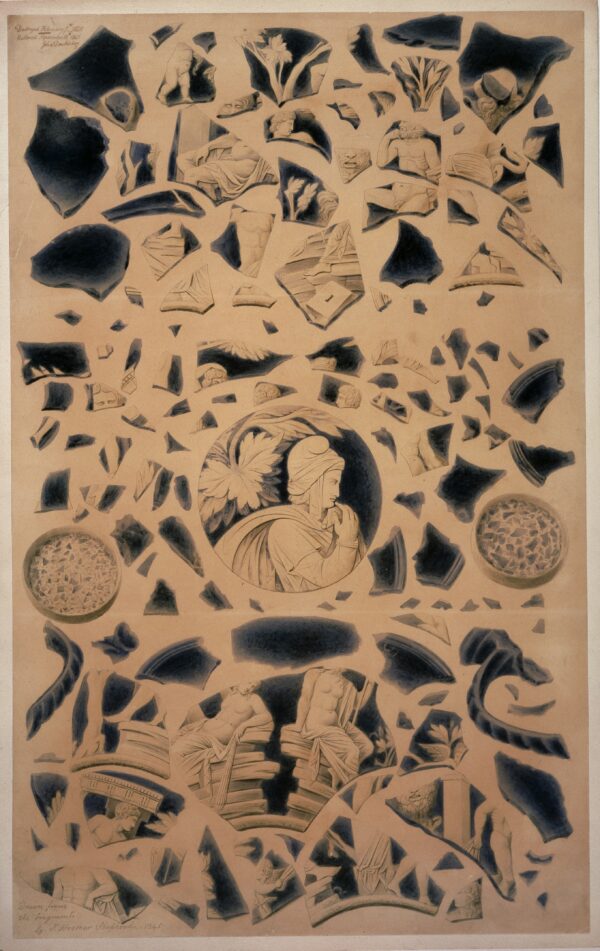 Fragments of the Barberini Vase in an illustration, annotated with “Destroyed February 7th, 1845. Restored September 10th, 1845. John Doubleday.” (Trustees of The British Museum)
Fragments of the Barberini Vase in an illustration, annotated with “Destroyed February 7th, 1845. Restored September 10th, 1845. John Doubleday.” (Trustees of The British Museum)The British Museum used Wedgwood’s Portland Vase to repair the Barberini Vase from the 200 fragments. The vase was quickly mended, yet it wasn’t until years later that most of the remaining 37 shards of glass were reunited with the vase.
Making the Portland Vase
Wedgwood’s original Portland Vase was made in black or very dark blue Jasperware. This reinforced “how special Jasper is, how exclusive it is. And then, that it has this capability of being as fine as an ancient cameo glass vase,” Lead said.
Wedgwood’s Portland Vase is “still deemed as being one of the most difficult pieces that we make because you have to be quite physically strong to make it. There’s a lot of clay that needs to be manhandled,” Lead said. That’s 14 pounds of Jasper clay mixture to be exact, and that takes a Wedgwood thrower and turner nearly two hours to shape.
But physical strength is not enough, technical skills and artistry are also needed to authentically reproduce the vase. Decorating it, which includes the figure-making and ornamenting, takes nearly two days. All imperfections have to be copied perfectly, such as the Barberini Vase’s handles that are not quite level. “That requires quite a bit of skill to get them exactly as they ought to be,” Lead said.
The method for making the vase hasn’t changed since Wedgwood’s day. The first time any art piece is reproduced, a copy of the bas-relief is made using wax on a slate base, which is then cast in plaster. Clay is then pressed onto the plaster cast and this clay impression is fired and then is used and reused to make each ceramic decoration.
To make a bas-relief, Jasper clay mixture is pressed into the clay mold. A special tool is then used to carefully lift out the relief, which is then applied to the body of the unfired Jasper vase with a little bit of water.
Then the vase is dried and fired for 30 hours at 2,147 degrees Fahrenheit.
Since the creation of the first Wedgwood Portland Vase, the company has issued the vase in an entire array of colors, a multitude of sizes, and as reliefs on other objects. “It’s one of our iconic pieces,” Lead said.
First editions of Wedgwood’s Portland Vase can be seen at the Fogg Art Museum in Boston and the Museum of Art in Birmingham, Alabama.
To find out more about Josiah Wedgwood’s pottery, visit www.WedgwoodMuseum.org.uk
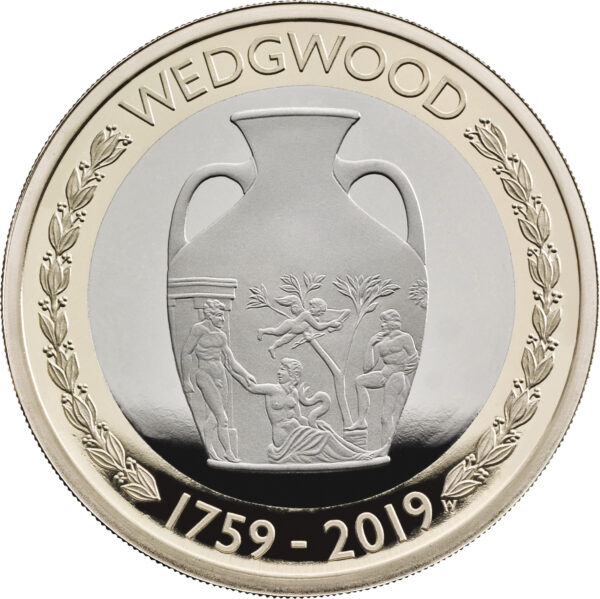 The Royal Mint’s commemorative coin features Wedgwood’s Portland Vase, to celebrate Wedgwood’s 260th anniversary. The coin’s edge is inscribed with “Everything gives way to experiment,” which is based on Josiah Wedgwood’s motto. (Fiskars UK Ltd.)
The Royal Mint’s commemorative coin features Wedgwood’s Portland Vase, to celebrate Wedgwood’s 260th anniversary. The coin’s edge is inscribed with “Everything gives way to experiment,” which is based on Josiah Wedgwood’s motto. (Fiskars UK Ltd.)This article is from the Internet:Josiah Wedgwood’s Portland Vase: The Pinnacle of Classical Perfection
Trump Expected to Delay European Auto Tariff Decision, Say EU Officials
